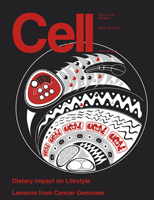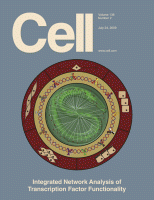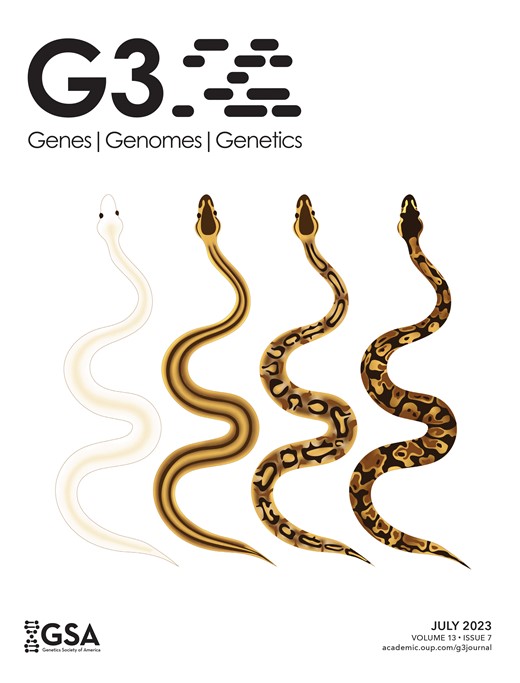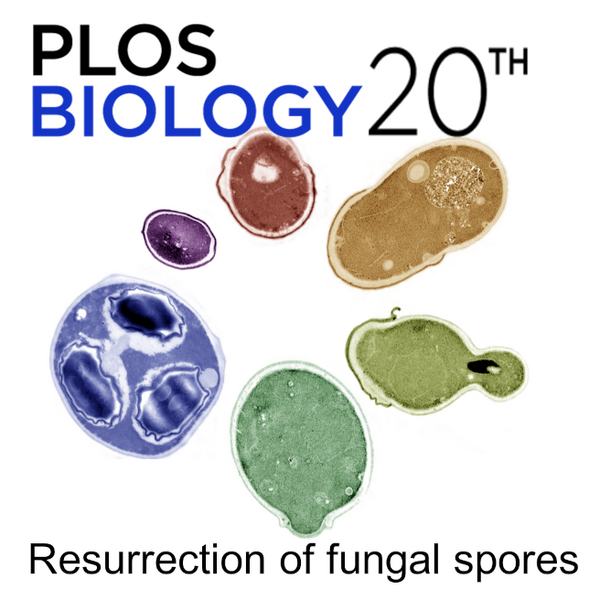Publications
Latest Publications
-
Oct 31, 2023
![A bacterial pathogen induces developmental slowing by high reactive oxygen species and mitochondrial dysfunction in Caenorhabditis elegans]()
-
Apr 29, 2023
![A transcriptional cofactor regulatory network for the C. elegans intestine.]()
-
Apr 12, 2023
![A D-2-hydroxyglutarate dehydrogenase mutant reveals a critical role for ketone body metabolism in Caenorhabditis elegans development]()
All Publications
2023
Mirza Z, Walhout AJM., Ambros V (2023). A bacterial pathogen induces developmental slowing by high reactive oxygen species and mitochondrial dysfunction in Caenorhabditis elegans. Cell Reports 42(10):113189.
Horowitz BB, Nanda S, Jacques MA, Walhout AJM. (2023). A transcriptional cofactor regulatory network for the C. elegans intestine. G3 jkad096.
Ponomarova O, Zhang H, Li X, Nanda S, Leland TB, Fox BW, Starbard AN, Giese GE, Schroeder FC, Yilmaz LS, Walhout AJM. (2023). A D-2-hydroxyglutarate dehydrogenase mutant reveals a critical role for ketone body metabolism in Caenorhabditis elegans development. PLoS Biol 21(4): e3002057.
Nanda S, Jacques MA, Wang W, Myers CL, Yilmaz LS, Walhout AJM. (2023). Systems-level transcriptional regulation of Caenorhabditis elegans metabolism. Mol Syst Biol e11443.
2022
Diot C, Garcia-Gonzalez AP, Vieria AF, Walker M, Honeywell M, Doyle H, Ponomarova O, Rivera Y, Na H, Zhang H, Lee M, Olsen CP, Walhout AJM. (2022). Bacterial diet modulates tamoxifen-induced death via host fatty acid metabolism. Nat Commun, 13:5595.
Bhattacharya S, Horowitz BB, Zhang J, Li X, Zhang H, Giese GE, Holdorf AD, Walhout AJM. (2022). A Metabolic Regulatory Network for the Caenorhabditis elegans intestine. iScience, 25(8):104688.
Fox BW, Ponomarova O, Lee YU, Zhang G, Giese GE, Walker M, Roberto NM, Na H, Rodrigues PR, Curtis BJ, Kolodziej AR, Crombie TA, Zdraljevic S, Yilmaz LS, Andersen EC, Schroeder FC, Walhout AJM. (2022). C. elegans as a model for inter-individual variation in metabolism. Nature, 607(7919):571-577.
Li X, Yilmaz LS, Walhout AJM. (2022). Compartmentalization of metabolism between cell types in multicellular organisms: a computational perspective. Curr Opin Syst Biol, 29:100407.
2021
Walker MD*, Giese GE*, Holdorf AD*, Bhattacharya S, Diot C, García-González AP, Horowitz B, Lee YU, Leland T, Li X, Mirza Z, Na H, Nanda S, Ponomarova O, Zhang H, Zhang J, Yilmaz LS, Walhout AJM. (2021). WormPaths: Caenorhabditis elegans metabolic pathway annotation and visualization. Genetics, 219:iyab089.
2020
Rosener B, Sayin S, Oluoch PO, García González AP, Mori H, Walhout AJ, Mitchell A. (2020). Evolved bacterial resistance against fluoropyrimidines can lower chemotherapy impact in the Caenorhabditis elegans host. eLife 9:e59831.
Yilmaz LS*, Li X*, Nanda S, Fox B, Schroeder F, Walhout AJM. (2020). Modeling tissue‐relevant Caenorhabditis elegans metabolism at network, pathway, reaction, and metabolite levels. Mol Syst Biol 16:e9649. PDF
Giese GE, Walker MD, Ponomarova O, Zhang H, Li X, Minevich G, Walhout AJM. (2020). C. elegans methionine/S-adenosylmethionine cycle activity is sensed and adjusted by a nuclear hormone receptor. eLife 9:e60259.
Na H*, Zdraljevic S*, Tanny RE, Walhout AJM, Andersen EC. (2020). Natural variation in a glucuronosyltransferase modulates propionate sensitivity in a C. elegans propionic acidemia model. PLoS Genet 16(8):e1008984. PDF
Holdorf AD, Higgins DP, Hart AC, Boag PR, Pazour GJ, Walhout AJM, Walker AK. (2020). WormCat: An online tool for annotation and visualization of Caenorhabditis elegans genome-scale data. Genetics 214, 279-94. PDF
2019
Diot C, Garcia-Gonzalez AP, Walhout AJM. (2019). C. elegans and its bacterial diet: An interspecies model to explore the effects of microbiota on drug response. Drug Discovery Today: Disease Models.
Zhang J, Li X, Olmedo M, Holdorf AD, Shang Y, Artal-Sanz M, Yilmaz LS, Walhout AJM. (2019). A delicate balance between bacterial iron and reactive oxygen species supports optimal C. elegans development. Cell Host Microbe 26, 400-411.
Giese GE, Nanda S, Holdorf AD, Walhout AJM. (2019). Transcriptional regulation of metabolic flux: a C. elegans perspective. Curr Opin Syst Biol 15, 12-18.
Bulcha JT, Giese GE, Ali MZ, Lee Y-U, Walker MD, Holdorf AD, Yilmaz LS, Brewster RC, Walhout AJM. (2019). A persistence detector for metabolic network rewiring in an animal. Cell Reports 26, 460-468. PDF
2018
Hu Q, D’Amora DR, MacNeil LT, Walhout AJM, Kubiseski TJ. (2018). The Caenorhabditis elegans Oxidative stress response requires the NHR-49 transcription factor. G3 ePub, g3.200727.2018.
Mookerjee-Basu J, Hua X, Ge L, Nicolas E, Li Q, Czyzewicz P, Zhongping D, Peri S, FuxmanBass JI, Walhout AJM, Kappes DJ. (2018). Functional conservation of a developmental switch in mammals since the Jurassic age. Mol Biol Evol ePub, msy191.
Walhout AJM. (2018). If two deletions don’t stop growth, try three. Science 360(6386), 269–270.
Huimin N, Ponomarova O, Giese GE, Walhout AJM. (2018). C. elegans MRP-5 exports vitamin B12 from mother to offspring to support embryonic development. Cell Rep 22, 3126-3133. PDF
Reece-Hoyes JS, Walhout AMJ. (2018). Gateway Recombinational Cloning. Cold Spring Harb Protoc 2018(1):pdb.top094912.
2017
García-González AP, Walhout AJM. (2017). Worms, bugs and drugs: Caenorhabditis elegans as a model for host-microbe-drug interactions. Curr Opin Sys Biol 6, 46-50. PDF
Mori A, Holdorf AD, Walhout AJM. (2017). Many transcription factors contribute to C. elegans growth and fat storage. Genes to Cells 22, 770-84. PDF
Hu Q, D’Amora DR, MacNeil LT, Walhout AJM, Kubiseski TJ. (2017). The oxidative stress response in Caenorhabditis elegans requires the GATA transcription factor ELT-3 and SKN-1/Nrf2. Genetics 206, 1909-22.
García-González AP, Ritter AD, Shrestha S, Andersen EC, Yilmaz LS, Walhout AJM. (2017). Bacterial metabolism affects the C. elegans response to cancer chemotherapeutics. Cell 169, 431-41. PDF
Tamburino AM, Kaymak E, Shresta S, Holdorf AD, Ryder SP, Walhout AJM. (2017). PRIMA: a gene-centered, RNA-to-protein method for mapping RNA-protein interactions. Translation 5, e1295130. PDF
Zhang J, Holdorf AD, Walhout AJ. (2017). C. elegans and its bacterial diet as a model for systems-level understanding of host–microbiota interactions. Curr Opin Biotechnol 46, 74-80. PDF
Yilmaz LS, Walhout AJM. (2017). Metabolic network modeling with model organisms. Curr Opin Chem Biol 36, 32-39. PDF
2016
Fuxman Bass JI, Reece-Hoyes JS, Walhout AMJ. (2016). Gene-centered yeast one-hybrid assay. Cold Spring Harb Protoc 2016(12):pdb.top077669.
Fuxman Bass, JI, Pons, C, Kozlowski, L, Reece‐Hoyes,JS, Shrestha, S, Holdorf, AD, Mori, A, Myers, CL, Walhout, AJM. (2016). A gene‐centered C. elegans protein–DNA interaction network provides a framework for functional predictions. Mol Sys Biol 12: 884. PDF
Andrews BJ, Walhout AJM, Iyengar R, The Human Cells Project Working Group. (2016). Quantitative human cell encyclopedia. Sci Signal 9, mr1.
Watson E, Olin-Sandoval V, Hoy MJ, Li C, Louisse T, Yao V, Mori A, Holdorf AD, Troyanskaya OG, Ralser M, Walhout AJM. (2016). Metabolic network rewiring of propionate flux compensates vitamin B12 deficiency in C. elegans. eLife 2016;5:e17670. PDF
Yilmaz LS, Walhout AJM. (2016). A Caenorhabditis elegans genome-scale metabolic network model. Cell Systems 2, 297–31. PDF
2015
Watson E, Yilmas LS, Walhout AJ. (2015). Understanding metabolic regulation at a systems level: metabolite sensing, mathematical predictions, and model organisms. Annu Rev Genet 49, 553-575. PDF
MacNeil LT, Pons C, Arda HE, Giese GE, Myers CL, Walhout AJM. (2015). Transcription factor activity mapping of a tissue-specific in vivo gene regulatory network. Cell Systems 1, 152-162. PDF
Fuxman Bass JI, Sahni N, Shrestha S, Garcia-Gonzalez A, Mori A, Bhat N, Yi S, Hill DE, Vidal M, Walhout AJM. (2015). Human gene-centered transcription factor networks for enhancers and disease variants. Cell 161, 661–73. PDF
Sahni N*, Yi S*, Taipale M*, Fuxman Bass JI*, Coulombe-Huntington J*, Yang F, Peng J, Weile J, Karras GI, Wang Y, Kovács IA, Kamburov A, Krykbaeva I, Lam MH, Tucker G, Khurana V, Sharma A, Liu Y, Yachie N, Zhong Q, Shen Y, Palagi A, San-Miguel A, Fan C, Balcha D, Dricot A, Jordan DM, Walsh JM, Shah AA, Yang X, Stoyanova AK, Leighton A, Calderwood MA, Jacob Y, Cusick ME, Salehi-Ashtiani K, Whitesell LJ, Sunyaev S, Berger B, Barabási A, Charloteaux B, Hill DE, Hao T, Roth FP, Yu X, Walhout AJM, Lindquist S, Vidal M. (2015). Widespread macromolecular interaction perturbations in human genetic disorders. Cell 161, 647–60. PDF
Narasimhan K, Lambert SA, Yang AW, Riddell J, Mnaimneh S, Zheng H, Albu M, Najafabadi HS, Reece-Hoyes JS, Fuxman Bass JI, Walhout AJ, Weirauch MT, Hughes TR. (2015). Mapping and analysis of Caenorhabditis elegans transcription factor sequence specificities. eLife 10.7554/eLife.06967.
Conte D, MacNeil LT, Walhout AJ, Mello CC. (2015). RNA interference in Caenorhabditis elegans. Curr Protoc Mol Biol 109:26.3.1-26.3.30.
2014
Weirauch MT, Yang A, Albu M, Cote AG, Montenegro-Montero A, Drewe P, Najafabadi HS, Lambert SA, Mann I, Cook K, Zheng H, Goity A, van Bakel H, Lozano JC, Galli M, Lewsey MG, Huang E, Mukherjee T, Chen X, Reece-Hoyes JS, Govindarajan S, Shaulsky G, Walhout AJ, Bouget FY, Ratsch G, Larrondo LF, Ecker JR, Hughes TR. (2014). Determination and inference of eukaryotic transcription factor sequence specificity. Cell 158:1431-43.
Yilmaz LS and Walhout AJ. (2014). Worms, bacteria, and micronutrients: an elegant model of our diet. Trends Genetics 30, 496-503. PDF
Liu WJ, Reece-Hoyes JS, Walhout AJ, Eisenmann DM. (2014). Multiple transcription factors directly regulate Hox gene lin-39 expression in ventral hypodermal cells of the C. elegans embryo and larva, including the hypodermal fate regulators LIN-26 and ELT-6. BMC Dev Bio 14:17.
Watson E and Walhout AJ. (2014) Caenorhabditis elegans metabolic gene regulatory networks govern the cellular economy. Trends Endocrinol. Metab. 25, 502-508. PDF
Watson E, MacNeil LT, Ritter AD, Yilmaz LS, Rosebrock AP, Caudy AA, Walhout AJ. (2014). Interspecies systems biology uncovers metabolites affecting C. elegans gene expression and life history traits. Cell 156:759-70. PDF
Walhout AJ. (2014). Genetic adaptation to diet preserves longevity. Cell Metab. 19:177-8. PDF
Fuxman Bass JI, Tamburino AM, Mori A, Beittel N, Weirauch MT, Reece-Hoyes JS, Walhout AJ. (2014). Transcription factor binding to Caenorhabditis elegans first introns reveals lack of redundancy with gene promoters. Nucleic Acids Res 42:153-62. PDF
2013
MacNeil LT, Walhout AJ. (2013). Food, pathogen, signal: The multifaceted nature of a bacterial diet. Worm 2:e26454. PDF
Fuxman Bass JI, Diallo A, Nelson J, Soto JM, Myers CL, Walhout AJ. (2013). Using networks to measure similarity between genes: association index selection. Nat Methods. 10:1169–1176. Erratum in: Nat Methods 11:349. PDF
Reece-Hoyes JS, Pons C, Diallo A, Mori A, Shrestha S, Kadreppa S, Nelson J, Diprima S, Dricot A, Lajoie BR, Ribeiro PS, Weirauch MT, Hill DE, Hughes TR, Myers CL, Walhout AJ. (2013). Extensive rewiring and complex evolutionary dynamics in a C. elegans multiparameter transcription factor network. Mol. Cell 51:116-27. PDF

MacNeil LT, Watson E, Arda HE, Zhu LJ, Walhout AJ. (2013). Diet-Induced developmental acceleration independent of TOR and insulin in C. elegans. Cell 153:240-252. PDF
Watson E*, MacNeil LT*, Arda HE, Zhu LJ, Walhout AJ. (2013). Integration of metabolic and gene regulatory networks modulates the C. elegans dietary response. Cell 153:253-266. PDF
Ritter AD, Shen Y, Fuxman Bass J, Jeyaraj S, Deplancke B, Mukhopadhyay A, Xu J, Driscoll M, Tissenbaum HA, Walhout AJ. (2013). Complex expression dynamics and robustness in C. elegans insulin networks. Genome Res. 23:954-65. PDF
Tamburino AM, Ryder SP, Walhout AJ. (2013). A compendium of Caenorhabditis elegans RNA binding proteins predicts extensive regulation at multiple levels. G3 3:297-304. PDF
2012
Reece-Hoyes JS, Walhout AJ. (2012). Gene-centered yeast one-hybrid assays. Methods Mol Biol 812:189-208.
Feng H, Reece-Hoyes JS, Walhout AJ, Hope IA. (2012). A regulatory cascade of three transcription factors in a single specific neuron, DVC, in Caenorhabditis elegans. Gene 494:73-84.
2011
Adams DJ, Berger B, Harismendy O, Huttenhower C, Liu XS, Myers CL, Oshlack A, Rinn JL, Walhout AJ. (2011). Genomics in 2011: challenges and opportunities. Genome Biol 12:137.
Walhout AJ. (2011). Gene-centered regulatory network mapping. Methods Cell Biol 106:271-88. PDF
Reece-Hoyes JS, Barutcu AR, McCord RP, Jeong JS, Jiang L, MacWilliams A, Yang X, Salehi-Ashtiani K, Hill DE, Blackshaw S, Zhu H, Dekker J, Walhout AJ. (2011). Yeast one-hybrid assays for gene-centered human gene regulatory network mapping. Nat Methods 8:1050-52. PDF
Reece-Hoyes JS, Diallo A, Lajoie B, Kent A, Shrestha S, Kadreppa S, Pesyna C, Dekker J, Myers CL, Walhout AJ. (2011). Enhanced yeast one-hybrid assays for high-throughput gene-centered regulatory network mapping. Nat Methods 8:1059-64. PDF
Gaudinier A, Zhang L, Reece-Hoyes JS, Taylor-Teeples M, Pu L, Liu Z, Breton G, Pruneda-Paz JL, Kim D, Kay SA, Walhout AJ, Ware D, Brady SM. (2011). Enhanced Y1H assays for Arabidopsis. Nat Methods 8:1053-5.
Tabuchi TM, Deplancke B, Osato N, Zhu LJ, Barrasa MI, Harrison MM, Horvitz HR, Walhout AJ, Hagstrom KA. (2011). Chromosome-biased binding and gene regulation by the Caenorhabditis elegans DRM complex. PLoS Genet. 7:e1002074.
Walhout AJ. (2011). What does biologically meaningful mean? A perspective on gene regulatory network validation. Genome Biol 12:109. PDF
De Masi F, Grove CA, Vedenko A, Alibés A, Gisselbrecht SS, Serrano L, Bulyk ML, Walhout AJ. (2011). Using a structural and logics systems approach to infer bHLH-DNA binding specificity determinants. Nucleic Acids Res 39:4553-63. PDF
MacNeil LT, Walhout AJ. (2011). Gene regulatory networks and the role of robustness and stochasticity in the control of gene expression. Genome Res 21:645-57. PDF
Brady SM, Zhang L, Megraw M, Martinez NJ, Jiang E, Yi CS, Liu W, Zeng A, Taylor-Teeples M, Kim D, Ahnert S, Ohler U, Ware D, Walhout AJ, Benfey PN. (2011). A stele-enriched gene regulatory network in the Arabidopsis root. Mol Syst Biol 7:459.
2010
Arda HE, Taubert S, MacNeil LT, Conine CC, Tsuda B, Van Gilst M, Sequerra R, Doucette-Stamm L, Yamamoto KR, Walhout AJ. (2010). Functional modularity of nuclear hormone receptors in a Caenorhabditis elegans metabolic gene regulatory network. Mol Syst Biol 6:367. PDF
Arda HE, Walhout AJ. (2010). Gene-centered regulatory networks. Brief Funct Genomics 9:4-12. PDF
2009

Walhout AJ. (2009). Getting an edge on human disease. Mol Syst Biol 5:322. PDF
Grove CA, De Masi F, Barrasa MI, Newburger DE, Alkema MJ, Bulyk ML, Walhout AJ. (2009). A multiparameter network reveals extensive divergence between C. elegans bHLH transcription factors. Cell 138:314-27. PDF
Reece-Hoyes JS, Deplancke B, Barrasa MI, Hatzold J, Smit RB, Arda HE, Pope PA, Gaudet J, Conradt B, Walhout AJ. (2009). The C. elegans Snail homolog CES-1 can activate gene expression in vivo and share targets with bHLH transcription factors. Nucleic Acids Res 37:3689-98. PDF
Martinez NJ, Walhout AJ. (2009). The interplay between transcription factors and microRNAs in genome-scale regulatory networks. Bioessays 31:435-45. PDF
2008
Martinez NJ, Ow MC, Reece-Hoyes JS, Barrasa MI, Ambros VR, Walhout AJ. (2008). Genome-scale spatiotemporal analysis of Caenorhabditis elegans microRNA promoter activity. Genome Res. 18:2005-15. PDF
Ow MC, Martinez NJ, Olsen PH, Silverman HS, Barrasa MI, Conradt B, Walhout AJ, Ambros V. (2008). The FLYWCH transcription factors FLH-1, FLH-2, and FLH-3 repress embryonic expression of microRNA genes in C. elegans. Genes Dev. 22:2520-34.
Martinez NJ, Ow MC, Barrasa MI, Hammell M, Sequerra R, Doucette-Stamm L, Roth FP, Ambros VR, Walhout AJ. (2008). A C. elegans genome-scale microRNA network contains composite feedback motifs with high flux capacity. Genes Dev. 22:2535-49. PDF
Grove CA, Walhout AJ. (2008). Transcription factor functionality and transcription regulatory networks. Mol Biosyst 4:309-14.
Mukhopadhyay A, Deplancke B, Walhout AJ, Tissenbaum HA. (2008). Chromatin immunoprecipitation (ChIP) coupled to detection by quantitative real-time PCR to study transcription factor binding to DNA in Caenorhabditis elegans. Nat Protoc 3:698-709.
2007
Vermeirssen V, Deplancke B, Barrasa MI, Reece-Hoyes JS, Arda HE, Grove CA, Martinez NJ, Sequerra R, Doucette-Stamm L, Brent MR, Walhout AJ. (2007). Matrix and Steiner-triple-system smart pooling assays for high-performance transcription regulatory network mapping. Nat Methods 4:659-64. PDF
Vermeirssen V, Barrasa MI, Hidalgo CA, Babon JA, Sequerra R, Doucette-Stamm L, Barabási AL, Walhout AJ. (2007). Transcription factor modularity in a gene-centered C. elegans core neuronal protein-DNA interaction network. Genome Res 17:1061-71. PDF
Reece-Hoyes JS, Shingles J, Dupuy D, Grove CA, Walhout AJ, Vidal M, Hope IA. (2007). Insight into transcription factor gene duplication from Caenorhabditis elegans Promoterome-driven expression patterns. BMC Genomics 8:27.
Barrasa MI, Vaglio P, Cavasino F, Jacotot L, Walhout AJ. (2007). EDGEdb: a transcription factor-DNA interaction database for the analysis of C. elegans differential gene expression. BMC Genomics 8:21. PDF
2006
Walhout AJ. (2006). Unraveling transcription regulatory networks by protein-DNA and protein-protein interaction mapping. Genome Res 16:1445-54. PDF
Walhout AJ. (2006). Networking at the second Interactome Meeting. Expert Rev Proteomics 3:477-9.
Deplancke B, Vermeirssen V, Arda HE, Martinez NJ, Walhout AJ. (2006). Gateway-compatible yeast one-hybrid screens. CSH Protoc 2006(5).
Wang Y, Oh SW, Deplancke B, Luo J, Walhout AJ, Tissenbaum HA. (2006). C. elegans 14-3-3 proteins regulate life span and interact with SIR-2.1 and DAF-16/FOXO. Mech Ageing Dev 127:741-7.
Deplancke B, Mukhopadhyay A, Ao W, Elewa AM, Grove CA, Martinez NJ, Sequerra R, Doucette-Stamm L, Reece-Hoyes JS, Hope IA, Tissenbaum HA, Mango SE, Walhout AJ. (2006). A gene-centered C. elegans protein-DNA interaction network. Cell 125:1193-205. PDF
2005
Reece-Hoyes JS, Deplancke B, Shingles J, Grove CA, Hope IA, Walhout AJ. (2005). A compendium of Caenorhabditis elegans regulatory transcription factors: a resource for mapping transcription regulatory networks. Genome Biol 6:R110. PDF
Davison EM, Harrison MM, Walhout AJ, Vidal M, Horvitz HR. (2005). lin-8, which antagonizes Caenorhabditis elegans Ras-mediated vulval induction, encodes a novel nuclear protein that interacts with the LIN-35 Rb protein. Genetics 171:1017-31.
Mukhopadhyay A, Deplancke B, Walhout AJ, Tissenbaum HA. (2005). C. elegans tubby regulates life span and fat storage by two independent mechanisms. Cell Metab 2:35-42.
2004
Deplancke B, Dupuy D, Vidal M, Walhout AJ. (2004). A gateway-compatible yeast one-hybrid system. Genome Res 14:2093-101. PDF
Dupuy D, Li QR, Deplancke B, Boxem M, Hao T, Lamesch P, Sequerra R, Bosak S, Doucette-Stamm L, Hope IA, Hill DE, Walhout AJ, Vidal M. (2004). A first version of the Caenorhabditis elegans promoterome. Genome Res 14:2169-75.
Han JD, Bertin N, Hao T, Goldberg DS, Berriz GF, Zhang LV, Dupuy D, Walhout AJ, Cusick ME, Roth FP, Vidal M. (2004). Evidence for dynamically organized modularity in the yeast protein-protein interaction network. Nature 430:88-93.
Fisk Green R, Lorson M, Walhout AJ, Vidal M, van den Heuvel S. (2004). Identification of critical domains and putative partners for the Caenorhabditis elegans spindle component LIN-5. Mol Genet Genomics 271:532-44.
2003
Ge H, Walhout AJ, Vidal M. (2003). Integrating ‘omic’ information: a bridge between genomics and systems biology. Trends Genet 19:551-60.
2002
Walhout AJ, Reboul J, Shtanko O, Bertin N, Vaglio P, Ge H, Lee H, Doucette-Stamm L, Gunsalus KC, Schetter AJ, Morton DG, Kemphues KJ, Reinke V, Kim SK, Piano F, Vidal M. (2002). Integrating interactome, phenome, and transcriptome mapping data for the C. elegans germline. Curr Biol 12:1952-8.
Huang NN, Mootz DE, Walhout AJ, Vidal M, Hunter CP. (2002) MEX-3 interacting proteins link cell polarity to asymmetric gene expression in Caenorhabditis elegans. Development 129:747-59.
Endoh H, Vincent S, Jacob Y, Réal E, Walhout AJ, Vidal M. (2002). Integrated version of reverse two-hybrid system for the postproteomic era. Methods Enzymol 350:525-45.
2001
Davy A, Bello P, Thierry-Mieg N, Vaglio P, Hitti J, Doucette-Stamm L, Thierry-Mieg D, Reboul J, Boulton S, Walhout AJ, Coux O, Vidal M. (2001). A protein-protein interaction map of the Caenorhabditis elegans 26S proteasome. EMBO Rep 2:821-8.
Walhout AJ, Vidal M. (2001). High-throughput yeast two-hybrid assays for large-scale protein interaction mapping. Methods 24:297-306.
Walhout AJ, Vidal M. (2001). Protein interaction maps for model organisms. Nat Rev Mol Cell Biol 2:55-62.
2000
Endoh H, Walhout AJ, Vidal M. (2000). A green fluorescent protein-based reverse two-hybrid system: application to the characterization of large numbers of potential protein-protein interactions. Methods Enzymol 328:74-88.
Walhout AJ, Temple GF, Brasch MA, Hartley JL, Lorson MA, van den Heuvel S, Vidal M. (2000). GATEWAY recombinational cloning: application to the cloning of large numbers of open reading frames or ORFeomes. Methods Enzymol 328:575-92.
Walhout AJ, Boulton SJ, Vidal M. (2000). Yeast two-hybrid systems and protein interaction mapping projects for yeast and worm. Yeast 17:88-94.
Walhout AJ, Sordella R, Lu X, Hartley JL, Temple GF, Brasch MA, Thierry-Mieg N, Vidal M. (2000). Protein interaction mapping in C. elegans using proteins involved in vulval development. Science 287:116-22.
1990s
Walhout AJ, Vidal M. (1999). A genetic strategy to eliminate self-activator baits prior to high-throughput yeast two-hybrid screens. Genome Res 9:1128-34.
Walhout AJ, van der Vliet PC, Timmers HT. (1998). Sequences flanking the E-box contribute to cooperative binding by c-Myc/Max heterodimers to adjacent binding sites. Biochim Biophys Acta 1397:189-201.
Walhout AJ, Gubbels JM, Bernards R, van der Vliet PC, Timmers HT. (1997). c-Myc/Max heterodimers bind cooperatively to the E-box sequences located in the first intron of the rat ornithine decarboxylase (ODC) gene. Nucleic Acids Res 25:1493-501.
Kruyt FA, Folkers GE, Walhout AJ, van der Leede BJ, van der Saag PT. (1993). E1A functions as a coactivator of retinoic acid-dependent retinoic acid receptor-beta 2 promoter activation. Mol Endocrinol 7:604-15.



